|
Anatomy of a Netsuke
By Robyn Buntin
Japan during the 17th century was a world without pockets. To carry
medicines, tobacco, seals, and other small personal affects required one to hang
them from their obi, or sash. From this need sprung various sets or kits, such
as the tobacco pouch, the inro, and the yatate (writing set). The inro was a
layered box with two to seven tiers that could contain various small objects.
The inro was held together by braided silk cords, which ran vertically through
the many layers. Keeping these braided cords together was an ojime, or bead,
which finally ended in a toggle piece called a netsuke. The netsuke was tucked
under the obi and helped to suspend the inro below. Through human nature, these
elements began to serve as more than just their utilitarian use. They became
expressions of the artist who created them and the individual taste of the
wearer.
Although the Japanese did not have jewelry in the Western sense of
the word, they most certainly knew about craftsmanship, artistry, decoration and
adornment. These small sets of accessories became highly refined and reflected
great sophistication. Inro were usually made of wood coated in lacquer,
decorated with gold and silver inlays. Ojime and netsuke were crafted out of
wood, ivory, ceramic or metal. A true inro suite would consist of an inro,
ojime, and netsuke sharing a unified theme.
Just as women today covet their
Prada bags and Manolo Blahnik shoes, inro suites were prized for their artistry
and elegance. Rarely do we find the inro suites intact with their matching
components. In the world of Japanese art, there are collectors who are drawn to
the exquisite beauty of the inro boxes, which often demonstrate the most
sophisticated lacquer work to be found. Bead enthusiasts marvel at the intricacy
and refinement of the tiny ojime beads. Netsuke themselves are collected for
their sculptural nature and ingenious miniature designs. Function provided the
stage upon which Japanese artists could perform their magic.
In form, there
are five main types of netsuke, each measuring approximately one inch tall by
one inch wide by one inch deep: manju, ryusa, kagamibuta, sashi, and katabori.
Manju, ryusa, and kagamibuta are flattened sphere shapes. As you may have
guessed, the manju netsuke is named after the Japanese confection that it
resembles. The ryusa netsuke is similar in shape, but is hollow inside, and the
design on either side is carved through to the center. Kagamibuta is more like a
flattened round pumpkin, where the body is made of ivory and the lid is made of
metal. With kagamibuta, the metal lid is usually incised with a design or inlaid
with gold or silver to create a design in relief.
Katabori netsuke are
carved completely in three dimensions, the carving detailing each part of the
figure or subject. These are particularly collectible because of their detail
and sculptural quality. Sashi netsuke are easy to identify by their elongated
form. They are carved on all sides like the katabori, but are thin and almost
seem to be stretched out. These basic shapes lent themselves to the function of
netsuke as well as the materials available.
Remember, since they functioned
liked oversized buttons, they had to follow at least a few practical rules. They
had to have a means of attaching the braided silk cord (usually easily
identifiable as two holes in the netsuke), and a compact and unobtrusive shape,
which would allow a user to wear it easily without breaking it.
Netsuke
artists, or netsuke-shi, created every conceivable sculpture within the confines
of the tiny netsuke form. At first being a simple piece of bamboo and evolving
into master works of artisanship, you are sure to find netsuke that speak to
you. For samurai, they may have sported netsuke illustrating their favorite
legendary warrior, executed in iron by the atelier of their swordmaker.
In
all art forms and all ages, there is a range of quality, from crude shapes to
the most subtle and ingenious. Older antique netsuke are prized for their style
and patina, the subtle wear upon an ivory or wood surface that speaks of
hundreds of years of use. In Hawaii, it would be interpreted as mana, or a
particular energy that a piece acquires throughout its life.
These older
netsuke are also fascinating because of the era which they reflect. Many netsuke
allude to famous legends or favorite subjects of old Japan, but they also
mirrored the changing times. During the 19th and early 20th century, you find
rare netsuke that are actually compasses, flints or model guns (non-shooting of
course). There are also contemporary netsuke-shi creating brand new works
combining the netsuke traditions and their own inspirations.
Collecting Netsuke
A good rule of thumb for any collection is to create
one that you will enjoy. I have always delighted in seeing netsuke which show a
special sensitivity to the natural material. Many netsuke-shi will take the
natural variation of color or shape in the material to subtly enhance the
carving itself. There are others who are drawn to particular legends or the
beauty of a specific substance, like ivory.
On aspects of authenticity, it
is generally agreed that netsuke created during the time that they were actually
used (pre-1920s), are termed "real". Works created after this date were usually
meant as tourist curios for export. There are a few noted master craftsmen who
carried on the tradition during this time period and whose netsuke are
considered to be of equal caliber to the antiques.
From the early 1980s
until the present, there has been a flux of reproduction netsuke coming out of
Hong Kong, Japan and the United States. These netsuke are most commonly
identifiable by observing the inferior level of carving. They are quickly made
with little finesse, but many "tricks" to make one believe there is great
detail.
Another clue to its authenticity is its practicality. If the netsuke
has protuberances that would make it an unwieldy item to wear, it's unlikely
that it was truly intended for its function.
Netsuke by contemporary
artists, however, is deeply rooted in traditional forms and often display a
level of technical craftsmanship rarely seen. Artists like Gernot Schluifer and
Lynn Richardson have become celebrated contemporary netsuke artists because of
their expressive and sensitive renderings.
The I.M. Chait Gallery of Beverly
Hills recently held an International and Fine Asian Arts Auction that featured
the netsuke shown in the photos in this article.
About the
author: Robyn Buntin is the owner of Robyn Buntin of Honolulu, an Asian antiques
gallery on Oahu. Buntin's offerings cross the spectrum from 14th-century armored
statues to tiny ivory and fruitwood netsuke. His webpage is
www.robynbuntin.com.
Description of items on the
cover: (From l-r, top to bottom)
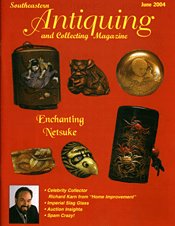 Finely executed three-case lacquer inro
with inlaid design of a fisherman on a great fish, and glass ojime,
$2,100. Finely executed three-case lacquer inro
with inlaid design of a fisherman on a great fish, and glass ojime,
$2,100.
19th c. wood netsuke of a crouching shi shi clinging to the openwork
ball, signed Sat Masayoshi, $325.
19th c. gold lacquer manju netsuke with
boy-with-butterflies design, signed Ko(Mitsu), $500.
Ca. 1900 carved hornbill
netsuke of a tray holding leaves and rat, inlaid eyes, red sheathing on sides,
$150.
19th c. carved marine ivory netsuke of a mask, inlaid eyes,
$75.
Black, red and gilt lacquer four-case inro with crab design and
mother-of-pearl inlay.
06/2004
|
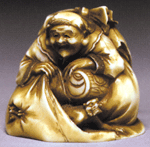
Carved ivory netsuke of an old man crouching in a sack and accompanied by
creatures, signed Mitsuyuki, 19th c.
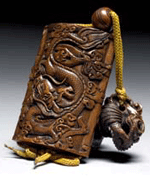
Finely detailed, antique single-case carved wood inro with scrolling dragons
in clouds; wood ojime and wood netsuke of a twining dragon blowing flames,
inlaid eyes, signed, $1,500.
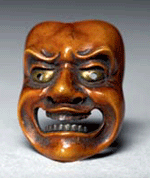
Carved wood mask netsuke, metal inlaid eyes and application to teeth, 19th c.,
$750.
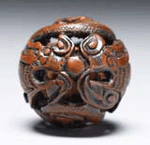
Finely carved, openwork wood "dragon ball" netsuke with two writing dragons and
a "pearl", unsigned, 19th c., $200.
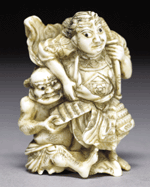
Finely detailed and carved ivory
netsuke of a standing warrior in
full
armor with an oni seated to his
side, inlaid eyes, unsigned, 19th c., $750.
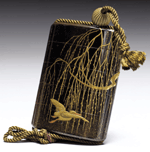
Four-case black and gilt lacquer inro with design of a metal-applied bird on a
branch; metal ojime, signed "Koma Yasutada," $2,500.
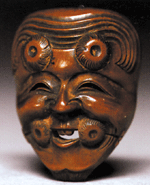
Antique carved wood netsuke mask, signed Deme Kuniharu, 19th c., $300.
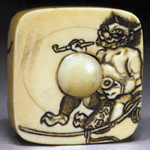
Ivory manju netsuke of square shape, showing a carved seated oni smoking a pipe,
signed, 19th c., $550.
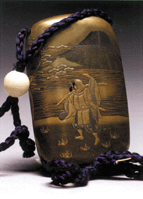
Finely detailed four-case gilt and polychrome lacquer inro with design of
figures in a landscape; wood ojime, 18th/19th c., $2,400.
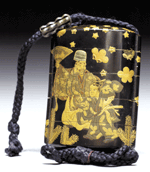
Antique five-case black and gilt lacquer inro with design of a masked dancer
and two figures with fans in foliage; metal ojime, $1,500. |